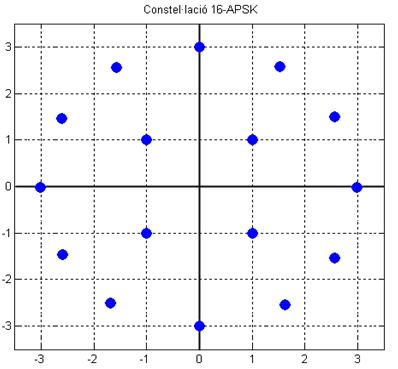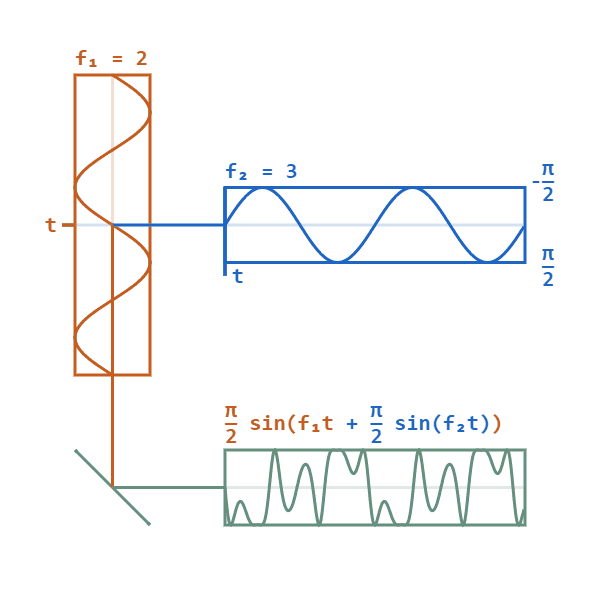|
Angle Modulation
Angle modulation is a class of carrier modulation that is used in telecommunications transmission systems. The class comprises frequency modulation (FM) and phase modulation (PM), and is based on altering the frequency or the phase, respectively, of a carrier signal to encode the message signal. This contrasts with varying the amplitude of the carrier, practiced in amplitude modulation (AM) transmission, the earliest of the major modulation methods used widely in early radio broadcasting. Foundation In general form, an analog modulation process of a sinusoidal carrier wave may be described by the following equation: :m(t) = A(t) \cdot \cos(\omega t + \phi(t))\,. ''A(t)'' represents the time-varying amplitude of the sinusoidal carrier wave and the cosine-term is the carrier at its circular frequency \omega, and the instantaneous phase deviation \phi(t). This description directly provides the two major groups of modulation, amplitude modulation and angle modulation. In amplitud ... [...More Info...] [...Related Items...] OR: [Wikipedia] [Google] [Baidu] |
Modulation
In electronics and telecommunications, modulation is the process of varying one or more properties of a periodic waveform, called the '' carrier signal'', with a separate signal called the ''modulation signal'' that typically contains information to be transmitted. For example, the modulation signal might be an audio signal representing sound from a microphone, a video signal representing moving images from a video camera, or a digital signal representing a sequence of binary digits, a bitstream from a computer. The carrier is higher in frequency than the modulation signal. In radio communication the modulated carrier is transmitted through space as a radio wave to a radio receiver. Another purpose is to transmit multiple channels of information through a single communication medium, using frequency-division multiplexing (FDM). For example in cable television which uses FDM, many carrier signals, each modulated with a different television channel, are transported through a ... [...More Info...] [...Related Items...] OR: [Wikipedia] [Google] [Baidu] |
Amplitude And Phase-shift Keying
Amplitude and phase-shift keying (APSK) is a digital modulation scheme that conveys data by modulating both the amplitude and the phase of a carrier wave. In other words, it combines both amplitude-shift keying (ASK) and phase-shift keying (PSK). This allows for a lower bit error rate for a given modulation order and signal-to-noise ratio, at the cost of increased complexity, compared to ASK or PSK alone. Quadrature amplitude modulation (QAM) can be considered a subset of APSK because all QAM schemes modulate both the amplitude and phase of the carrier. Conventionally, QAM constellations are rectangular and APSK constellations are circular, however this is not always the case. The distinction between the two is in their production; QAM is produced from two orthogonal signals. The advantage of APSK over conventional QAM is a lower number of possible amplitude levels and therefore a lower peak-to-average power ratio (PAPR). The resilience of APSK to amplifier and channel no ... [...More Info...] [...Related Items...] OR: [Wikipedia] [Google] [Baidu] |
WiFi
Wi-Fi () is a family of wireless network protocols, based on the IEEE 802.11 family of standards, which are commonly used for local area networking of devices and Internet access, allowing nearby digital devices to exchange data by radio waves. These are the most widely used computer networks in the world, used globally in home and small office networks to link desktop and laptop computers, tablet computers, smartphones, smart TVs, printers, and smart speakers together and to a wireless router to connect them to the Internet, and in wireless access points in public places like coffee shops, hotels, libraries and airports to provide visitors with Internet access for their mobile devices. ''Wi-Fi'' is a trademark of the non-profit Wi-Fi Alliance, which restricts the use of the term ''Wi-Fi Certified'' to products that successfully complete interoperability certification testing. the Wi-Fi Alliance consisted of more than 800 companies from around the world. over 3.05 bi ... [...More Info...] [...Related Items...] OR: [Wikipedia] [Google] [Baidu] |
Digital Subscriber Line
Digital subscriber line (DSL; originally digital subscriber loop) is a family of technologies that are used to transmit digital data over telephone lines. In telecommunications marketing, the term DSL is widely understood to mean asymmetric digital subscriber line (ADSL), the most commonly installed DSL technology, for Internet access. DSL service can be delivered simultaneously with wired telephone service on the same telephone line since DSL uses higher frequency bands for data. On the customer premises, a DSL filter on each non-DSL outlet blocks any high-frequency interference to enable simultaneous use of the voice and DSL services. The bit rate of consumer DSL services typically ranges from 256 kbit/s to over 100 Mbit/s in the direction to the customer ( downstream), depending on DSL technology, line conditions, and service-level implementation. Bit rates of 1 Gbit/s have been reached. In ADSL, the data throughput in the upstream direction (the directi ... [...More Info...] [...Related Items...] OR: [Wikipedia] [Google] [Baidu] |
Phase Modulation
Phase modulation (PM) is a modulation pattern for conditioning communication signals for transmission. It encodes a message signal as variations in the instantaneous phase of a carrier wave. Phase modulation is one of the two principal forms of angle modulation, together with frequency modulation. In phase modulation, the instantaneous amplitude of the baseband signal modifies the phase of the carrier signal keeping its amplitude and frequency constant. The phase of a carrier signal is modulated to follow the changing signal level (amplitude) of the message signal. The peak amplitude and the frequency of the carrier signal are maintained constant, but as the amplitude of the message signal changes, the phase of the carrier changes correspondingly. Phase modulation is widely used for transmitting radio waves and is an integral part of many digital transmission coding schemes that underlie a wide range of technologies like Wi-Fi, GSM and satellite television. It is also used for ... [...More Info...] [...Related Items...] OR: [Wikipedia] [Google] [Baidu] |
Synthesizer
A synthesizer (also spelled synthesiser) is an electronic musical instrument that generates audio signals. Synthesizers typically create sounds by generating waveforms through methods including subtractive synthesis, additive synthesis and frequency modulation synthesis. These sounds may be altered by components such as filters, which cut or boost frequencies; envelopes, which control articulation, or how notes begin and end; and low-frequency oscillators, which modulate parameters such as pitch, volume, or filter characteristics affecting timbre. Synthesizers are typically played with keyboards or controlled by sequencers, software or other instruments, and may be synchronized to other equipment via MIDI. Synthesizer-like instruments emerged in the United States in the mid-20th century with instruments such as the RCA Mark II, which was controlled with punch cards and used hundreds of vacuum tubes. The Moog synthesizer, developed by Robert Moog and first sol ... [...More Info...] [...Related Items...] OR: [Wikipedia] [Google] [Baidu] |
FM Synthesis
Frequency modulation synthesis (or FM synthesis) is a form of sound synthesis whereby the frequency of a waveform is changed by modulating its frequency with a modulator. The frequency of an oscillator is altered "in accordance with the amplitude of a modulating signal". FM synthesis can create both harmonic and inharmonic sounds. To synthesize harmonic sounds, the modulating signal must have a harmonic relationship to the original carrier signal. As the amount of frequency modulation increases, the sound grows progressively complex. Through the use of modulators with frequencies that are non-integer multiples of the carrier signal (i.e. inharmonic), inharmonic bell-like and percussive spectra can be created. FM synthesis using analog oscillators may result in pitch instability. However, FM synthesis can also be implemented digitally, which is more stable and became standard practice. Digital FM synthesis (implemented as phase modulation) was the basis of several musical instr ... [...More Info...] [...Related Items...] OR: [Wikipedia] [Google] [Baidu] |
Two-way Radio
A two-way radio is a radio that can both transmit and receive radio waves (a transceiver), unlike a broadcast receiver which only receives content. It is an audio (sound) transceiver, a transmitter and receiver in one unit, used for bidirectional person-to-person voice communication with other users with similar radios. Two-way radios are available in stationary (base station), mobile (installed in vehicles), and hand-held portable models. Hand-held two-way radios are often called walkie-talkies, handie-talkies or hand-helds. Two-way radios are used by groups of geographically separated people who need to keep in continuous voice communication, such as aircraft pilots and air traffic controllers, ship captains and harbormasters, emergency services personnel like firefighters, police officers, and ambulance paramedics, taxi and delivery services, soldiers and military units, fast food and warehouse employees, and radio amateurs. Two-way radio systems may use a single radio ... [...More Info...] [...Related Items...] OR: [Wikipedia] [Google] [Baidu] |
Edwin Armstrong
Edwin Howard Armstrong (December 18, 1890 – February 1, 1954) was an American electrical engineer and inventor, who developed FM (frequency modulation) radio and the superheterodyne receiver system. He held 42 patents and received numerous awards, including the first Medal of Honor awarded by the Institute of Radio Engineers (now IEEE), the French Legion of Honor, the 1941 Franklin Medal and the 1942 Edison Medal. He was inducted into the National Inventors Hall of Fame and included in the International Telecommunication Union's roster of great inventors. Armstrong attended Columbia University, and served as a professor there for most of his life. Early life Armstrong was born in the Chelsea district of New York City, the oldest of John and Emily (née Smith) Armstrong's three children. His father began working at a young age at the American branch of the Oxford University Press, which published bibles and standard classical works, eventually advancing to the position of ... [...More Info...] [...Related Items...] OR: [Wikipedia] [Google] [Baidu] |
Radio Programming
Radio programming is the process of organising a schedule of radio content for commercial broadcasting and public broadcasting by radio stations. History The original inventors of radio, from Guglielmo Marconi's time on, expected it to be used for one-on-one wireless communication tasks where telephones and telegraphs could not be used because of the problems involved in stringing copper wires from one point to another, such as in ship-to-shore communications. Those inventors had no expectations whatever that radio would become a major mass media entertainment and information medium earning many millions of dollars in revenues annually through radio advertising commercials or sponsorship. These latter uses were brought about after 1920 by business entrepreneurs such as David Sarnoff, who created the National Broadcasting Company (NBC), and William S. Paley, who built Columbia Broadcasting System (CBS). These broadcasting (as opposed to narrowcasting) business organizations ... [...More Info...] [...Related Items...] OR: [Wikipedia] [Google] [Baidu] |
FM Broadcasting
FM broadcasting is a method of radio broadcasting using frequency modulation (FM). Invented in 1933 by American engineer Edwin Armstrong, wide-band FM is used worldwide to provide high fidelity sound over broadcast radio. FM broadcasting is capable of higher fidelity—that is, more accurate reproduction of the original program sound—than other broadcasting technologies, such as AM broadcasting. It is also less susceptible to common forms of interference, reducing static and popping sounds often heard on AM. Therefore, FM is used for most broadcasts of music or general audio (in the audio spectrum). FM radio stations use the very high frequency range of radio frequencies. Broadcast bands Throughout the world, the FM broadcast band falls within the VHF part of the radio spectrum. Usually 87.5 to 108.0 MHz is used, or some portion thereof, with few exceptions: * In the former Soviet republics, and some former Eastern Bloc countries, the older 65.8–74 MHz band ... [...More Info...] [...Related Items...] OR: [Wikipedia] [Google] [Baidu] |
Frequency Modulation
Frequency modulation (FM) is the encoding of information in a carrier wave by varying the instantaneous frequency of the wave. The technology is used in telecommunications, radio broadcasting, signal processing, and computing. In analog frequency modulation, such as radio broadcasting, of an audio signal representing voice or music, the instantaneous frequency deviation, i.e. the difference between the frequency of the carrier and its center frequency, has a functional relation to the modulating signal amplitude. Digital data can be encoded and transmitted with a type of frequency modulation known as frequency-shift keying (FSK), in which the instantaneous frequency of the carrier is shifted among a set of frequencies. The frequencies may represent digits, such as '0' and '1'. FSK is widely used in computer modems, such as fax modems, telephone caller ID systems, garage door openers, and other low-frequency transmissions. Radioteletype also uses FSK. Frequency modulatio ... [...More Info...] [...Related Items...] OR: [Wikipedia] [Google] [Baidu] |









